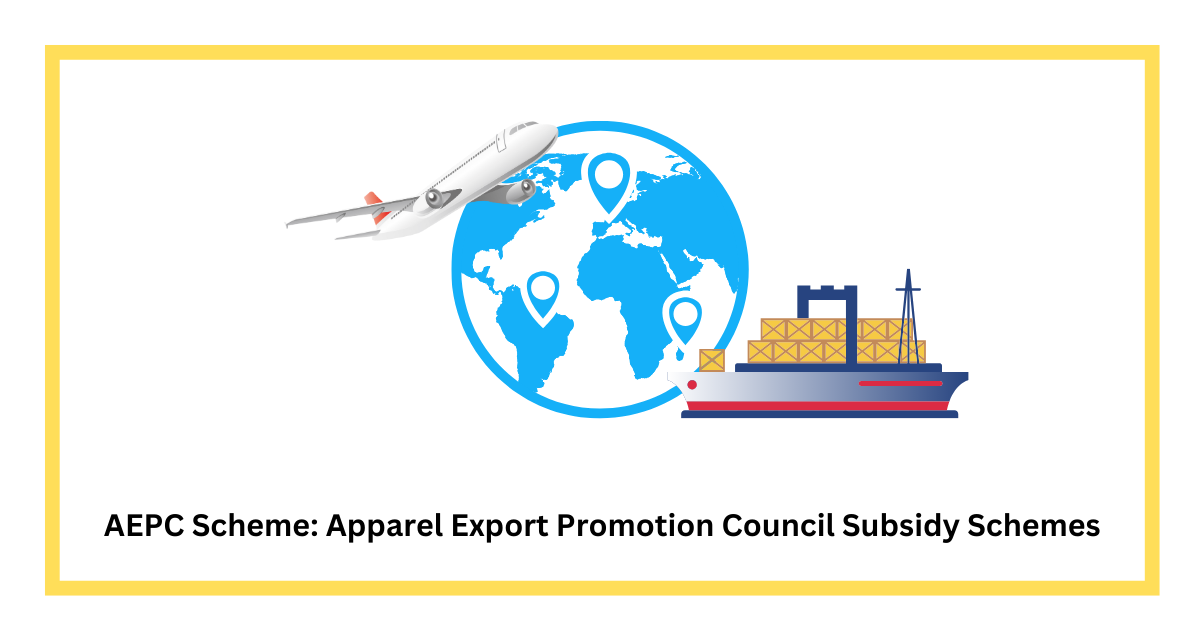Explore the subsidy schemes offered by the Apparel Export Promotion Council (AEPC). Learn about the initiatives supporting the apparel export industry, fostering growth, and providing financial assistance to eligible entities.
What Is AEPC?
The Apparel Export Promotion Council (AEPC) plays a crucial role in promoting and supporting India’s textile and apparel industry. Sponsored by the Ministry of Textiles, Government of India, AEPC focuses on initiatives to boost apparel exports, enhance market development, facilitate infrastructure development, and foster skill development in the textile sector. The council also encourages technology upgradation and promotes sustainability initiatives within the industry. Lets have a look at AEPC Scheme.
Here are some crucial facets of AEPC schemes in India –
AEPC (Apparel Export Promotion Council): The apex body responsible for overseeing and implementing various schemes to promote and support apparel exports from India.
Subsidy: Financial support provided to eligible entities, especially exporters, to encourage and facilitate their participation in the global market.
Exporters: Businesses engaged in the export of textile and apparel products, benefitting from AEPC schemes and initiatives.
Textile Industry: The broader sector encompassing the production of fabrics, yarns, and related materials, collaborates with AEPC for industry development.
Incentives: Rewards and benefits offered to exporters to stimulate and boost their export activities.
Market Development Assistance: Support provided to exporters for exploring and expanding their market reach globally.
Infrastructure Development: Initiatives aimed at enhancing the overall infrastructure of the textile and apparel industry, ensuring better production and export capabilities.
Skill Development: Programs and activities focused on training and upskilling the workforce in the textile sector, ensuring a skilled labour pool.
Technology Upgradation: Encouraging the adoption of advanced technologies to improve efficiency, innovation, and competitiveness within the industry.
Sustainability Initiatives: Efforts directed towards making the textile and apparel industry more environmentally sustainable, promoting eco-friendly practices.
What Are the Objectives of AEPC?
The AEPC scheme aligns with several overarching objectives, including:
Export Promotion: Actively promoting and facilitating the export of textile and apparel products to international markets.
Economic Growth: Contributing to the overall economic growth of the country through increased exports and industry development.
Trade Liberalisation: Supporting policies that encourage liberalised trade, making it easier for Indian textiles to access global markets.
Regional Integration: Fostering collaboration and integration with regional partners to strengthen the textile industry’s position in the global market.
Capacity Building: Enhancing the capacity of the industry by investing in skill development, technology adoption, and infrastructure.
Sustainable Development: Incorporating sustainable practices to ensure long-term environmental and economic viability.
Innovation and Technology Transfer: Encouraging innovation and facilitating the transfer of technology to keep the industry competitive.
Business Facilitation: Streamlining processes and providing support to businesses for smoother operations and international transactions.
Small and Medium-sized Enterprises (SMEs) Development: Focusing on the growth and development of small and medium-sized enterprises within the textile sector.
Benefits of AEPC Scheme:
Textile exporters participating in the AEPC scheme can reap various benefits, including:
Energy Efficiency: By implementing practices that reduce energy consumption and promote sustainable production.
Cost Savings: Through subsidies, exporters can enjoy cost savings, making their products more competitive in the global market.
Environmental Impact: Incorporating sustainable and eco-friendly practices can help minimise the industry’s environmental footprint.
Renewable Energy: Encouragement for the use of renewable energy sources to power textile manufacturing processes.
Employment Opportunities: Industry growth and capacity-building assistance for the creation of more job opportunities.
Reduced Dependence on Fossil Fuels: Moving towards cleaner and sustainable energy sources, reducing reliance on fossil fuels can be a great plus for exporters in the global world.
Health Benefits: Implementing environmentally friendly practices can lead to improved air and water quality, benefiting the total health of the community.
Infrastructure Development: Enhancing the overall infrastructure of the industry can lead to improved efficiency.
Energy Security: Diversifying energy sources and ensuring a secure and sustainable energy supply leads to energy security for exporters.
Public Awareness and Education: Creating awareness about sustainable practices and educating the public on the benefits of supporting eco-friendly products can generate goodwill for exporters.
Eligibility of AEPC Scheme:
Textile exporters eligible to participate in AEPC schemes typically fulfil the following conditions:
Organisation: Any registered organisation involved in textile and apparel export activities.
Country: Generally focused on Indian exporters participating in global trade.
Product Category: Specific schemes may target certain product categories within the textile and apparel sector.
Export Requirement: Meeting specific criteria related to export volumes, documentation, and compliance.
Documentation: Ensuring proper documentation and adherence to export regulations.
Compliance: Adhering to the rules and regulations set by AEPC and relevant export authorities.
Export Experience: Having a track record of successful export activities.
Financial Capability: Demonstrating financial stability and capability to engage in international trade.
Articles of Association: Complying with the legal requirements and regulations specified in the Articles of Association, which outline the internal rules and structure of the organization.
Quality Standards: Maintaining compliance with international quality standards for textile and apparel products, ensuring that the exported goods meet the required specifications.
Ethical Practices: Upholding ethical business practices and social responsibility, including adherence to labor standards and environmental regulations.
Technology Adoption: Embracing and implementing relevant technologies to enhance production efficiency, product quality, and overall competitiveness in the global market.
Market Research: Demonstrating a strategic approach to global trade by conducting thorough market research, understanding international trends, and adapting business strategies accordingly.
Intellectual Property Rights: Respecting and safeguarding intellectual property rights, including trademarks and patents, to prevent any legal issues related to the exported products.
Risk Management: Implementing effective risk management strategies to mitigate potential challenges in international trade, such as currency fluctuations, geopolitical issues, and market uncertainties.
Timely Compliance: Ensuring timely compliance with all reporting requirements, notifications, and submissions to the AEPC and other relevant authorities.
Training and Skill Development: Investing in the continuous training and skill development of employees to stay updated with industry trends, regulations, and technological advancements.
Innovation: Encouraging innovation in product design, manufacturing processes, and business models to stay competitive and capture new opportunities in the global market.
These eligibility criteria collectively contribute to fostering a dynamic and responsible textile and apparel export community, promoting sustainable growth and success in the international trade arena.
Apparel Export Promotion Council Subsidy Schemes
The textile industry in India is accountable for the requirements of the Agreement on Subsidies and Countervailing Measures (ASCM) which specifies that if an expanding country member’s exports of a commodity have attained a share of at least 3.25% of the world exchange of that commodity for two continuous calendar years, it will be deemed as export active in that product. Further, export subsidies on such commodities shall be deliberately phased out over eight years. As per this expenditure, India is obligated to phase out subsidies for export delegation.
To increase exports and enhance the competitiveness of the textiles division, the government has openly declared a special package for garments and start-up sectors. The subsidy gives Rebate of State Levies (RoSL), labor law reforms, more reasons under the Amended Technology Upgradation Fund Scheme (ATUFS), and relief from Section 80JJAA of the Income Tax Act.
The roll system has since been rebuilt by the system for Rebate of State and Central Taxes and Levies from 7 March 2019. Assistance is also provided to exporters under the Market Access Initiative (MAI) Scheme. The government has improved the attention equalisation rate for pre and post-shipment importance for exports achieved by MSMEs of the textile division from 3% to 5% from 2.11.2018.
The Goals of Interest Equalisation Scheme has been enhanced to merchant exporters from 2.01.2019 which was first prohibited to only factory exporters. Several techniques and supports can be benefited by exporters under the registration of the AEPC.
- AEPC’s market development schemes, comprise Exporters Availed Market Access Initiative Scheme, Technology Upgradation Funds Scheme (TUFS), Market Development Assistance Scheme, Focus Market Scheme, Textile Centre Infrastructure Development Scheme, Apparel Park, Scheme for Integrated Textiles Parks, and Special Economic Zones
- Interest Equalisation Scheme, or interest subvention, is an attention reduction ready on pre-and post-shipment export status, such as reserving credit
- Technology Upgradation Fund Scheme was inaugurated to promote modern and reasonable technology
- The Rebate of State Levies Scheme benefits the textile sector by giving zero-rated export taxes and putting up an all-around degree of competitiveness in the global market.
How Vakilsearch Can Help in AEPC Registration
There is no doubt that registration with AEPC will bring multiple benefits. Registering with AEPC Scheme is a tedious task. However, it can be conducted online on the official website. If you are not completely away it is better to reach out to our experts for any legal advice.
Experts at Vakilsearch handle more than 1000 companies every month and provide legal assistance to companies in India and abroad. Reach out to us and we will get a Spice board RCMC in just 30 working days. With our strong team of experienced business advisors, we can help you through the AEPC registration process.
Also, Read:










